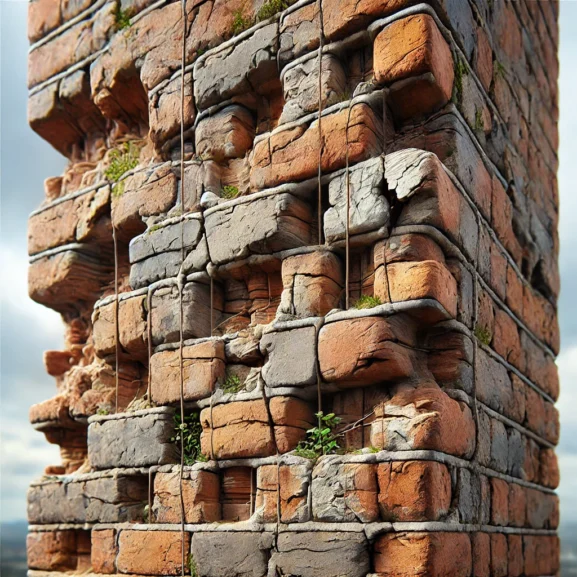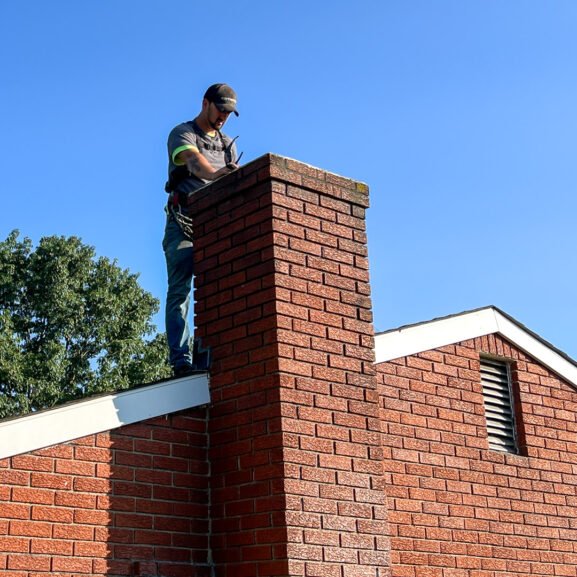Preventing Leaks into the Attic from Deteriorating Chimney Flashing: A Homeowner’s Guide
We often overlook the chimney when maintaining our homes. But it’s important to pay attention to it, especially the flashing. If the chimney flashing gets damaged, it can cause leaks in the attic. This can lead to water damage and costly repairs. Many homeowners face this issue but don’t know what causes it.
In this article, we’ll explain how chimney flashing works. We’ll also discuss why it breaks down and how to spot leaks. By understanding these points, we can protect our homes from water damage. We can keep our attics dry and safe. Let’s look at why maintaining chimney flashing is important and how to fix problems before they worsen.
Protect Your Home: What You Need to Know About Chimney Flashing
Chimney flashing is key to keeping the attic dry. It stops water from leaking into the house. When the flashing gets damaged, water can pour into the chimney. This can lead to water damage. And it’s definitely not the indoor waterfall we want!
Signs of Flashing Damage
- Water Stains: Yellow or brown stains in the attic are red flags for chimney leaks.
- Dripping Sound: Listen for water in places it shouldn’t be, like near your chimney.
- Visible Cracks: Notice gaps or rust on flashing? These need attention fast.
- Weather Impact: Harsh elements cause wear and tear.
- Poor Installation: Incorrect fitting can lead to leaks.
- Material Age: Over time, materials may corrode or break.
Importance of Professional Maintenance
Regular inspections and repairs by professionals prevent attic water damage. We’re experts at keeping roofs leak-free without the hassle of DIY disasters. Reach out to professionals for consultation. Remember, proactive maintenance is easier than surprising repair costs. For more tips, visit the Chimney Safety Institute of America and the National Fire Protection Association. They offer great safety advice.
Causes Of Deteriorating Chimney Flashing
Deteriorating chimney flashing results in issues like chimney leaks and attic water damage. Understanding these causes helps homeowners effectively maintain attic protection. If you’re dealing with these issues, reach out to professionals for consultation.
Weather Exposure
The weather can be tough on chimney flashing. Intense heat, cold, and heavy rain all cause damage. Every season, flashing expands and contracts. It’s like a water balloon on your roof, but not nearly as fun.
Exposure to harsh elements speeds up rust, especially if metal flashings are used. Rust leads to small holes and water infiltration. Visiting the Chimney Safety Institute of America website helps understand the role weather plays in chimney maintenance. Ensuring regular roof maintenance protects your home against weather-related issues.
Poor Installation
Poor installation practices lead to water infiltration and roof leaks. Misaligned or loose flashings create paths for water invasion. Experienced professionals should tackle installation, not us enthusiastic amateurs. Incorrect flashing overlap or inadequate sealing invites future trouble.
Homes require quality craftsmanship to endure local conditions. To prevent poor installation outcomes, we recommend relying on certified professionals. The National Fire Protection Association site guides on choosing skilled technicians.
Age And Wear
Time isn’t kind to chimney flashing. Over the years, even the best materials experience wear. When flashing approaches the end of its lifespan, vulnerabilities arise. Metal types corrode, and other materials wear down, leading to dreaded roof leaks.
Signs Of Leaks Into The Attic

Spotting leaks from chimney flashing is crucial for attic protection. Water damage can be costly, so early detection helps save on expensive repairs.
Water Stains And Discoloration
Noticing stains on your attic ceiling or walls might indicate chimney leaks. Stains often appear brown, yellow, or rust-colored. These water stains usually spread out like an awkward ink blot test. To avoid further attic water damage, prompt action is required. Keep an eye out when inspecting—common times after heavy rainstorms.
Musty Odors
A lingering musty odor in the attic might signal water infiltration. This smell results from trapped moisture and inadequate ventilation. It’s like having a puddle that never quite dries up, even when it’s sunny outside. Ignoring this can worsen the issue. Check the attic regularly, especially in wet months. Need more advice? Reach out to professionals for consultation or check the Chimney Safety Institute of America for more resources.
Assessment And Inspection Techniques
Detecting chimney leaks early can save us from big headaches—and expensive repairs. Ensuring thorough inspections makes it easier to spot flashing damage.
Professional Inspection
It’s best to call experts for a chimney check. They have the right tools to look for water leaks and damage to parts like chimney flashing. A professional can also find roof leaks and other issues that are often hard to see.
Roof Check: Experts will check the roof for loose or missing flashing. This keeps our attic protected.
Interior Signs: How can we spot issues inside? Water stains or a musty smell could mean there are chimney leaks that need fixing right away.
The weather in our area can be unpredictable, increasing the risk of flashing damage. Regular inspections can prevent water from getting into the attic by keeping the flashing in good condition. We recommend contacting the Chimney Safety Institute of America for regular advice. You can also reach out to the National Fire Protection Association for safety tips.
Don’t you want to fly solo here? Reach out to professionals for consultation! We promise not to advise any DIYs, so leave it to the pros.
Repair And Prevention Solutions
Fixing chimney flashing is vital to stopping attic water damage. Let’s explore some reliable repair options and preventive measures.
Repair Options
Addressing flashing damage starts with a thorough inspection. Professionals can assess leaks and reveal hidden issues. The solution might be re-sealing or replacing parts of the flashing. High-quality materials ensure durability in harsh weather. Experts can skillfully replace worn flashing, reducing the risk of future roof leaks.
We can’t stress this enough: Always contact experts for repairs. DIY attempts can make matters worse, sometimes resembling a rainy comedy show. Reach out to professionals for consultation. For more on chimney care, visit the Chimney Safety Institute of America and the National Fire Protection Association.
Preventive Measures

Prevention beats repair every time. Regular inspections are key to early detection of chimney leaks. Schedule checks after heavy rain or snow. This proactive approach protects your attic and roof from water infiltration. Sealant application helps as well, providing added defense against weather elements.
Unpredictable weather can be a challenge. Maintaining a maintenance schedule ensures your chimney remains leak-free. Remember, a dry attic is a happy attic! To keep yours smiling, reach out for professional help. Our team is ready to assist with both routine inspections and expert flashing repair. Reach out to professionals for consultation.
Conclusion
By keeping up with chimney flashing maintenance, we can protect our homes. It helps prevent expensive water damage. Regular checks will ensure the flashing stays in good condition. This simple task can save us from bigger repairs later. It’s important to spot the signs of leaks and understand what causes flashing to wear out. This allows us to take action before problems get worse. Hiring professionals helps us keep our chimneys in good condition. This also helps protect our attics from the weather. Let’s make regular inspections and quick repairs a priority. With expert help, we can ensure our homes stay strong and safe. If you’re ready to take the next step, reach out to professionals for consultation. We’ll help keep your attic dry and secure.
Frequently Asked Questions
What is chimney flashing, and why is it important?
Chimney flashing is a waterproof barrier installed around the base of chimneys. Its job is to stop water from seeping into the attic, keeping the attic dry and helping prevent water damage to the home’s structure. When installed correctly, flashing keeps leaks away, saving you from costly repairs caused by water damage.
How can I tell if my chimney flashing is deteriorating?
If you notice water stains or discoloration on your ceilings or walls, your chimney flashing may be deteriorating. This is a clear sign that something is wrong. These stains are often brown, yellow, or rust-colored. You might also hear dripping sounds or see visible cracks. A musty odor in your attic can also be a sign of water getting in. To catch these problems early, schedule regular inspections. Do this after extreme weather events. It helps spot issues before they get worse.
What causes chimney flashing to deteriorate?
Chimney flashing can wear out over time. Harsh weather, bad installation, and the natural aging of materials contribute to this. Extreme heat, cold, and heavy rain can cause more damage. This is especially true in places with unpredictable climates.
Why should I avoid DIY chimney flashing repairs?
Due to their complexity, DIY chimney flashing repairs can worsen issues. Improper repairs may create pathways for water infiltration, leading to further damage. Hiring skilled professionals ensures quality repairs and prevents costly mistakes.
How do professional inspections protect against chimney leaks?
Professional inspections help find hidden issues. They ensure the chimney flashing, roof, and attic are in good condition. Experts can spot damage that homeowners might miss. They offer reliable solutions to prevent water damage. This helps keep your attic dry.
When should I schedule chimney inspections?
It’s important to schedule regular chimney inspections, especially after heavy rain or snow. Inspections help catch problems early, which is important in areas with harsh weather. Regular checks make sure repairs are done on time. They also help protect your home from water damage.
What are preventive measures against chimney leaks?
To prevent problems, we should schedule regular inspections. Applying sealants can add extra protection. It’s also important to use high-quality materials for repairs. These steps help us spot leaks early and keep the chimney flashing strong against the weather.


